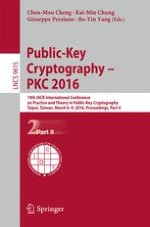2016 | OriginalPaper | Buchkapitel
On Generic Constructions of Circularly-Secure, Leakage-Resilient Public-Key Encryption Schemes
verfasst von : Mohammad Hajiabadi, Bruce M. Kapron, Venkatesh Srinivasan
Erschienen in: Public-Key Cryptography – PKC 2016
Verlag: Springer Berlin Heidelberg
Aktivieren Sie unsere intelligente Suche, um passende Fachinhalte oder Patente zu finden.
Wählen Sie Textabschnitte aus um mit Künstlicher Intelligenz passenden Patente zu finden. powered by
Markieren Sie Textabschnitte, um KI-gestützt weitere passende Inhalte zu finden. powered by
Abstract
-
KDM-projection security, an extension of circular security, where the adversary may also ask for encryptions of negated secret key bits;
-
a (\(1-o(1)\)) resilience rate in the bounded-memory leakage model of Akavia et al. (TCC 2009); and
-
Auxiliary-input security against subexponentially-hard functions.
